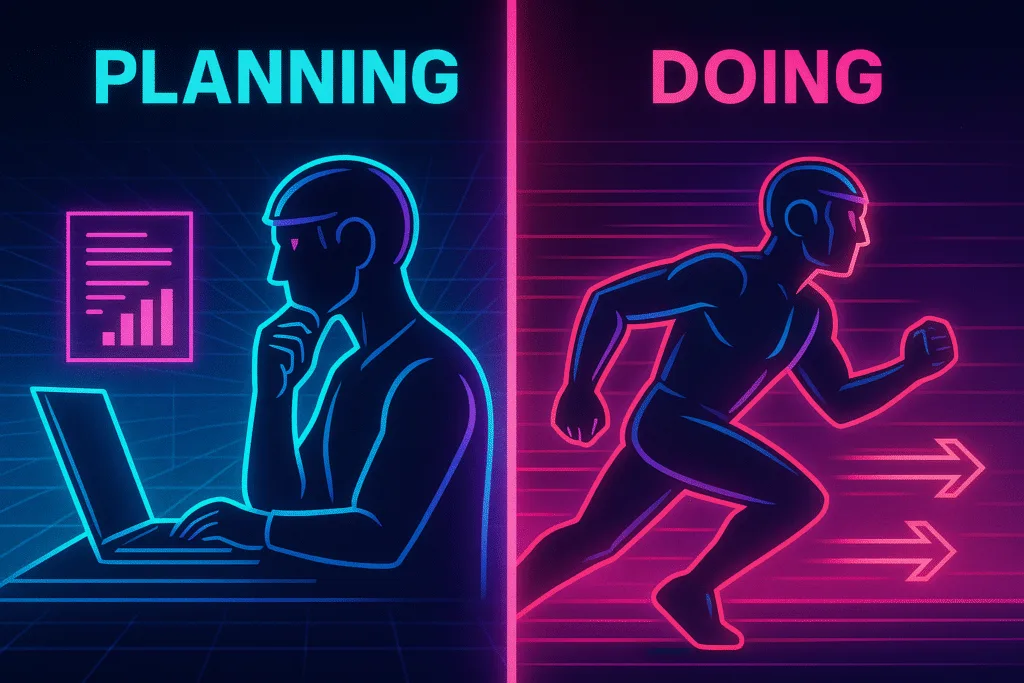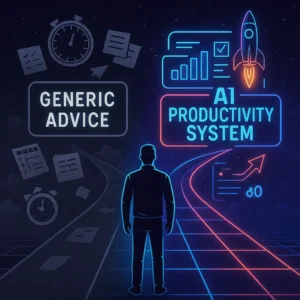Picture this: Two friends both decide to learn coding. One spends months researching programming languages, watching tutorials, and “preparing” to start. The other begins with a simple “Hello World” program on day one, making mistakes but learning from each attempt.
Six months later, who do you think is actually writing functional code?
Here’s the reality: Most people get trapped in endless preparation, mistaking planning for taking action. While research has its place, it’s the consistent small steps—even imperfect ones—that lead to real progress. The difference isn’t in motivation or capability—it’s in having an effective system that makes action inevitable rather than optional.
The good news? Learning how to take action isn’t about willpower or forcing yourself forward. It’s about building the right framework that makes progress natural and automatic.
Upgrades You’ll Receive From This Guide:
– A science-backed system to transform intentions into concrete actions
– Practical strategies to overcome procrastination and start moving forward today
– AI-powered techniques to personalize your action plan
– Proven methods to maintain momentum and make progress inevitable
Understanding Action: More Than Just Movement
The true take action meaning goes beyond simply being busy—it’s about creating real, measurable progress toward your goals. While motion involves planning, researching, and strategizing, taking action produces tangible results. Think of motion as organizing your workout clothes, while action is actually doing the pushups.
James Clear, author of “Atomic Habits,” explains that people often mistake motion for progress because it feels productive. However, only action creates change. Motion makes you feel good temporarily, but taking action transforms your reality.
Why Taking Action is so Hard:
Why taking action is so hard comes down to three key factors:
1. Fear of Failure: Our brains are wired to avoid potential threats, including the possibility of failing or looking foolish.
2. Decision Paralysis: With endless options and information available, we often get stuck trying to make the “perfect” choice.
3. Lack of System: Most people rely on motivation or willpower, which are unreliable, instead of having an automated framework for progress.
The Power of Commitment: Moving Beyond Decision to Action
Understanding how to take action is only half the battle—the other half is making an unshakeable commitment to follow through. Dr. Robert Cialdini, renowned psychology professor and author of “Influence,” explains that public commitments are particularly powerful because they tap into our deep psychological need for consistency.
Why Commitment Matters?
Research from the American Psychological Association shows that people who make explicit commitments are 2-3 times more likely to follow through compared to those who simply have good intentions. This isn’t just about willpower—it’s about creating what psychologists call “psychological closure,” a mental state that moves us from contemplation to action.
Aligning Action With Your Values: The Foundation of Meaningful Progress
Before diving into how to take action, let’s explore what makes actions stick—alignment with your personal values. Research from the University of Rochester shows that actions aligned with core values are 3x more likely to be maintained long-term compared to those driven by external pressure.
Why Values Matter in taking action When your actions align with your values, motivation becomes intrinsic rather than forced. Dr. Kelly McGonigal, Stanford psychologist, explains that value-aligned actions tap into our natural drive for authenticity and meaning, making consistent effort feel less like a struggle and more like a natural expression of who we are.
Discovering Your Core Values
- Identity Reflection Ask yourself:
- What matters most to me in life?
- When do I feel most alive and authentic?
- What would I stand up for, even if it cost me something?
- Peak Experience Analysis Think about your most fulfilling moments:
- What were you doing?
- Why did it feel meaningful?
- What values were being expressed? You can also read our blog on How to start a hard conversation
- Legacy Consideration Imagine looking back on your life:
- What impact do you want to have made?
- What principles do you want to have lived by?
- How do you want to be remembered?
Practical Strategies on How to Take Action
1. Embrace Imperfect Action
Replace perfectionism with a “good enough to start” mindset. Understand that everything can be improved through iteration. The first draft, attempt, or version doesn’t need to be perfect—it just needs to exist.
James Clear, author of “Atomic Habits,” emphasizes that successful people are willing to take imperfect action while others wait for ideal conditions. They understand that moving forward imperfectly beats standing still perfectly.
2. Adopt the Five-Minute Rule
When facing resistance to a task, commit to just five minutes of action. This tiny commitment bypasses psychological resistance because it feels manageable. Once you begin, you’ll often continue beyond those initial minutes as momentum takes over.
This technique works because starting is almost always more difficult than continuing. By lowering the threshold for beginning, you overcome the biggest obstacle to action.
3. Break Down Goals Into Micro-Actions
Large goals can be paralyzing. Instead of focusing on the endpoint, identify the smallest possible action you can take right now. Rather than “start a business,” your micro-action might be “research domain names for 15 minutes.”
Each micro-action should be:
- Specific enough to know exactly what to do
- Small enough to complete in one sitting
- Connected directly to your larger goal
4. Create External Accountability
We’re more likely to follow through when others expect action from us. Share your intentions with someone who will hold you accountable, join a group with similar goals, or work with a coach or mentor.
Public commitment increases follow-through because it adds a social cost to inaction. When others know about our intentions, we feel greater responsibility to act.
5. Address the Fear Factor
Acknowledge fears that prevent action, then reframe them as data rather than obstacles. Ask yourself: “What’s the worst that could happen? How likely is that outcome? What could I learn from failure?”
Remember that regret from inaction typically outweighs regret from action. Years later, people rarely regret the things they did—they regret the things they didn’t do.
Read More: How to Overcome Fear of Failure
6. Establish Routines, Not Reliance on Motivation
Motivation is fleeting and unreliable. Instead of waiting to feel motivated, build routines that trigger action regardless of your emotional state. Consistent action builds identity—you become the type of person who takes action, not just someone who wants to.
Morning routines are particularly powerful because they set the tone for your day before distractions and energy depletion occur.
Implementation Guide: Turning Strategies into Results
Now that you understand how to take action and the core strategies of taking action, let’s create a practical framework for putting them into action. Here’s your step-by-step guide to start taking action consistently:
Step 1: Choose Your Starting Point
– Select one important goal you want to achieve
– Break it down into the smallest possible first step
– Apply the Two-Minute Rule to make starting effortless
Step 2: Design Your Action Environment
– Clear your space of distractions
– Place necessary tools within easy reach
– Set up visual reminders of your goal
Step 3: Create Your Action Protocol
– Identify your peak energy times
– Link actions to existing habits
– Write specific when-then plans
Step 4: Build Your Support System
– Share your goal with one accountability partner
– Set up daily check-ins
– Track progress visually
AI-Powered Action Planning
Let’s leverage AI to create personalized action plans that keep you moving forward. Here’s how to use AI tools effectively to support your journey from intention to action:
Example AI Prompt Template:
“Based on my goal of [specific goal], create a detailed action plan that:
1. Breaks down the first week into daily micro-steps
2. Identifies potential obstacles and solutions
3. Suggests specific environment modifications
4. Provides progress tracking metrics
Consider that my peak energy time is [time] and I have [X] minutes available daily.”
Sample AI-Generated Action Plan:
Week 1 Micro-Steps:
– Day 1: Set up dedicated workspace (2 minutes)
– Day 2: Complete one problem-solving task (5 minutes)
– Day 3: Share progress with accountability partner (3 minutes)
– Day 4: Increase task duration by 2 minutes
– Day 5: Review and adjust environment setup
– Day 6: Double task duration
– Day 7: Reflect and plan Week 2
Environment Modifications:
– Clear workspace of non-essential items
– Place task materials in visible location
– Set up progress tracking board
– Install habit-tracking app
Progress Metrics:
– Daily action completion (yes/no)
– Time spent on task
– Energy level during action
– Obstacle occurrence and solutions
Advanced AI Prompt for Obstacle Planning:
“Analyze my current action plan for [goal] and:
1. Identify potential failure points
2. Suggest preventive measures
3. Create backup plans for common obstacles
4. Design recovery protocols for missed days”
Using AI for Building Momentum:
– Generate daily motivational prompts
– Create personalized reward systems
– Adjust difficulty based on progress
– Suggest habit stacking opportunities
Read More: Abundance vs Scarcity Mindset
Conclusion: How to Take Action
Taking action isn’t about dramatic changes or superhuman willpower. It’s about building simple, repeatable systems that make progress automatic. The difference between dreamers and achievers isn’t talent or luck—it’s having an effective framework that drives consistent action.
Start small. Choose one strategy from this guide—like the Two-Minute Rule—and take your first step within 24 hours. Remember, imperfect action beats perfect planning every time.
Track your progress, celebrate small wins, and keep moving forward. With the right system in place, turning your ideas into reality becomes not just possible, but inevitable.
Ready to Transform Action Into Unstoppable Momentum?
You’ve learned powerful strategies for taking action, but what if you could turn these methods into an engaging, automated system that makes progress feel effortless and exciting?
Introducing the Moore Momentum System – your complete solution for turning intentions into reality. We’ve combined behavioral science, AI technology, and proven principles into a gamified experience that makes taking action as engaging as your favorite apps.
The Moore Momentum System offers:
– AI-powered personalization that adapts to your unique style
– A gamified interface that turns daily actions into rewarding achievements
– Built-in accountability tools that keep you moving forward
– Science-backed methods to make action obvious, easy, and automatic
– A supportive community of action-takers building momentum together
Instead of relying on willpower or complex productivity systems, imagine having a digital companion that:
– Breaks down your big goals into manageable daily steps
– Provides personalized suggestions based on your energy and schedule
– Rewards your progress with meaningful achievements
– Keeps you accountable through engaging challenges
Remember: The difference between dreamers and achievers isn’t in their ideas—it’s in their system for taking action. Let us help you build that system.






